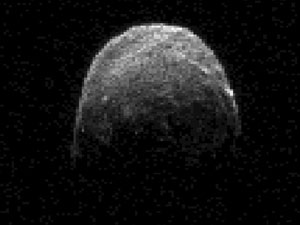I wasn’t going to post anything else about asteroid YU55 until the images became available, but NASA just put up a video explaining a little bit about how they plan on getting observations of the sucker as it flies past us over the next couple of days:
Just to clarify a bit: those radio telescopes can be used like radar guns, sending out short pulses of focused radio waves. These pulses are aimed at the asteroid and move at the speed of light, hitting the rock and bouncing back. Since we know the speed of light very accurately, we can measure the time it takes a pulse to get to the asteroid and back, multiply it by the speed of light, and get the distance (for example, if it takes 5 seconds, and the speed of light is 300,000 km/sec, that means the pulses traveled 1.5 million km round trip… so don’t forget to divide by 2 to get the distance to the rock).
 But there’s more! The individual pulses can be timed very accurately as well, so that the shape of the asteroid can be determined, too. If there is a bump on the asteroid, like a hill, then a pulse hitting that won’t travel quite as far as a pulse that hits a crater. It gets back sooner, and this can be measured. The spatial resolution of this method at the distance of YU 55 will be about 4 meters, so they’ll be able to make an image that’s about 100 pixels across of it.
But there’s more! The individual pulses can be timed very accurately as well, so that the shape of the asteroid can be determined, too. If there is a bump on the asteroid, like a hill, then a pulse hitting that won’t travel quite as far as a pulse that hits a crater. It gets back sooner, and this can be measured. The spatial resolution of this method at the distance of YU 55 will be about 4 meters, so they’ll be able to make an image that’s about 100 pixels across of it.
[UPDATE: In fact, this image here of YU55 was released like two minutes after I originally posted this article. It was taken using the Goldstone radio telescope in California on November 7, when YU 55 was still 1.4 million km (860,000 miles) from Earth!]
[Update 2: Emily Lakdawalla wrote a great discussion of all this on her blog last year; I highly recommend reading it!]
Not only that, but the wavelength of the pulses are very accurately known, too. If the asteroid is spinning, then the wavelengths of the returning pulses will be altered, like in the Doppler Effect. So all in all, we can determine the rock’s size, distance, shape, and rotation, just by painting it with radar.
That’s pretty good for a species that doesn’t even have to leave the ground. Still, we’d learn a whole lot more by actually going to these things. And we’ve done that, too. See Related posts, below.
We’re clever, we humans, when we want to be.
Image credit: NASA/JPL-Caltech
Related posts:
- Rosetta sends back gorgeous asteroid closeups
- Vesta’s odd bottom
- Stardust snaps close-ups of a second-hand comet!
- A comet creates its own snowstorm!